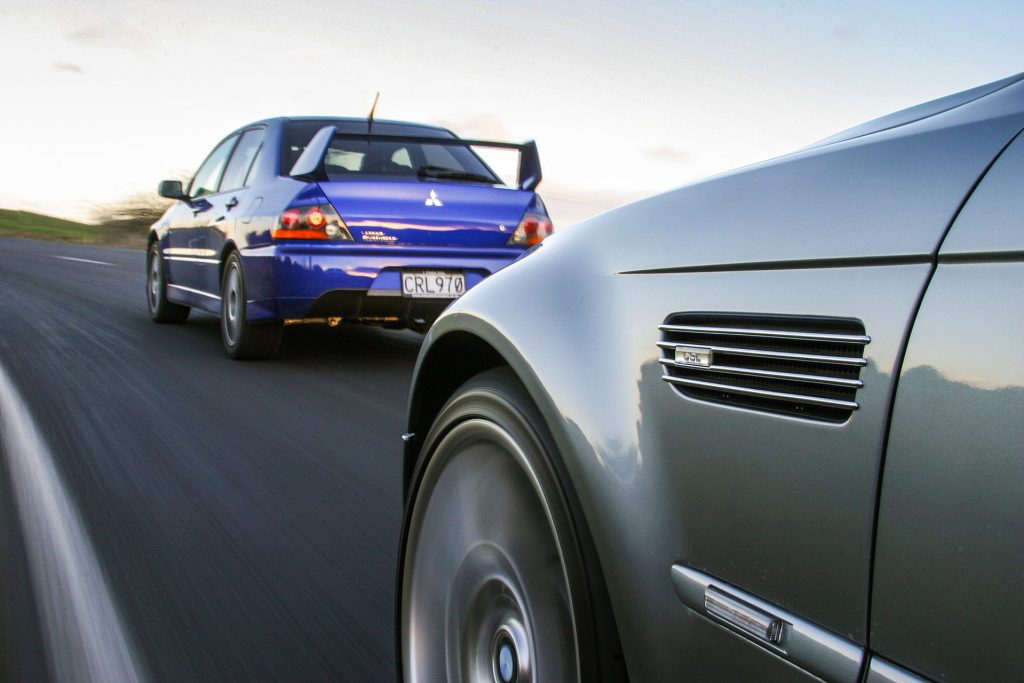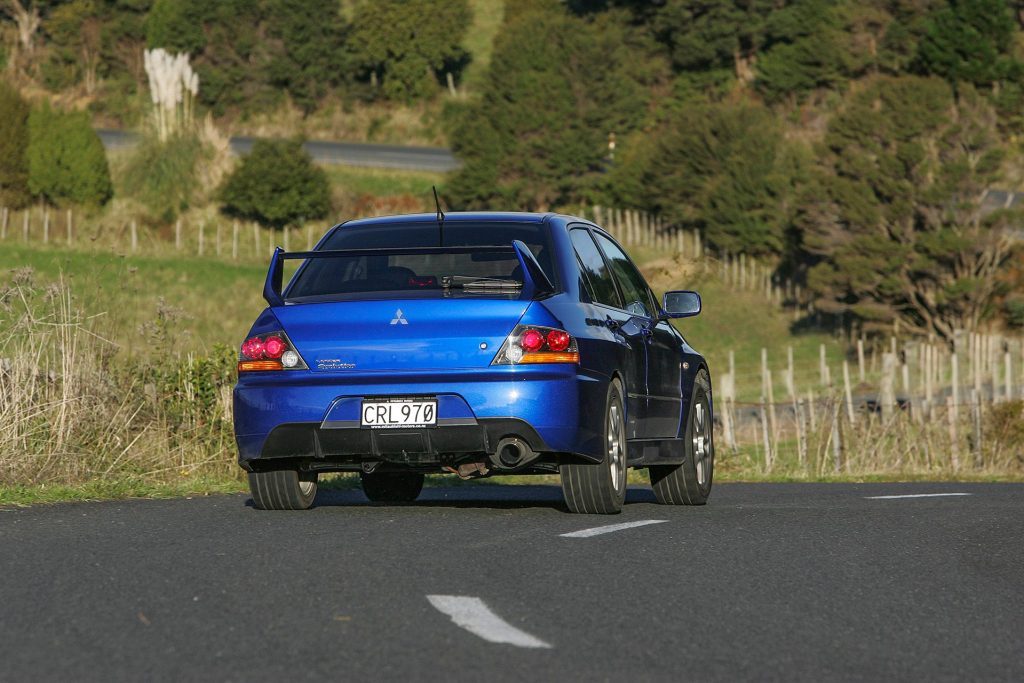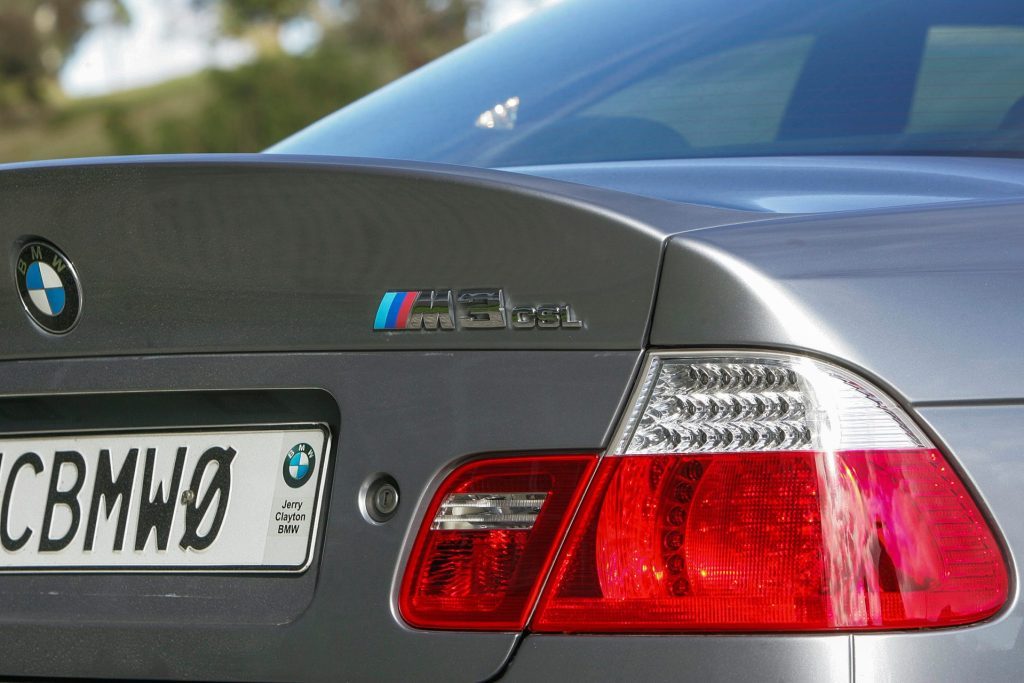2005 Mitsubishi Lancer Evolution IX vs BMW M3 CSL comparison
Words: Paul Owen | Photos: Tom Gasnier
The new Mitsubishi Evolution Lancer IX and the not-quite-so-new BMW M3 CSL are cars for nutters. They appeal to the most basic of human instincts, the most primal of our urges, and the quickest of the body’s reflexes. It’s best to leave logic back in the garage when driving either of these two.
‘Where’s the STi?’ many will ask on first viewing this article. The most super of Subs is the perennial nemesis of the Mitsi Evo both in rallies and on the road. The two affordable Japanese ‘rice rockets’ are as fierce rivals as Don and Helen, Skaife and Ingall, Rossi and Giblets, Alonso and the Ice Man. Yet we’ve done the ‘STi versus Evo’ thing so many times now that it’s in danger of becoming a cliché. Besides, regular readers already know the winner after the previous Evo VIII, helped in no small way by the New Zealand-spec FQ300 engine upgrade, shot down the latest, much-revised STi in the October 2004 issue. The IX is an even better car than any Evo that’s gone before it, including the home-brewed FQ300.

So what could be our benchmark for the enfant terrible of sports-sedans? A 300kW HSV perhaps? Nah, the ultra-nimble Evo would spindle, fold and mutilate the Big Fella as soon as the first corner arrived. A 4wd Porsche 911? Now we’re talking. Trouble is, as soon as Porsche dealers realised that one of their flock might be compared with an Evo, they all closed ranks and locked up their key cupboards anytime the magazine came begging. Philistines.
‘Access denied’ to Zuffenhausen’s finest got us thinking about the BMW M3 CSL – one of the few Bavarian cars to have fallen through the cracks in the editorial consciousness of this magazine, and which has been AWOL from our road-test list. BMW, as you know, uses the marketing slogan, “the ultimate driving machine” – a statement that could also describe the Evo’s reason to live. Kindly granted the keys to a near-new CSL by Jerry Clayton BMW, we set forth on a quest to identify the car from this pair that most lived up to the phrase.

Evos have always been top cars in terms of bang-for-buck, but could the best of the breed upstage a factory special from a German car maker with a proven record of F1 and Le Mans success? Could a $60k Japanese car compete on equal terms with a high-perf Euro that originally listed for over three times that sum?
To find the answers, we selected the top Evo IX, the $66,490 GSR version, to take advantage of its trick planetary-geared rear diff, suede- and leather-covered Recaro seats and added sixth gear. To access even a second-hand M3 CSL will cost most punters almost $100K more. Our titanium-coloured example wears a price sticker of $159,950 on the JCBMW lot – not bad value when you consider that this 13,000km 2003 model cost $199,900 when new. Just 12 CSL versions of the M3 came to New Zealand out of a 1500-unit limited production run, a factor that should ensure robust resale values for this car. In a city seemingly swamped by Porsches, a CSL definitely makes a more exclusive alternative.

The abbreviation stands for ‘Coupé Sports Light’, and the trusty NZ Autocar scales proved the mightiest M3 lives up to the classification. At 1410kg with a full tank, the M3 CSL weighed in an impressive 54kg lighter than the Evo – quite a feat when you consider it has another 1200cc of engine capacity and two extra cylinders. Both cars were fighting fit thanks to plenty of attention to weight-saving detail, but the BMW had taken the purge a little further than the Mitsi. There wasn’t even a stereo, although the previous owner had fitted the optional air conditioning (along with Goodyear Eagle F1 tyres, which are more sensible than the Michelin Pilot Sport Cup semi-slicks originally fitted to the CSL).
Both cars prune mass from the most sensitive places with real zeal. Mitsubishi uses plenty of Bluff’s second-best export (after the oysters) in its quest for a lighter car. Aluminium forms the roof, front fenders, lower suspension arms and bonnet, while lighter Inkei 17” alloys ensure this Evo compares favourably with the VIII. This is despite the IX’s weightier new components, such as the rear diff and variable-valve-timed cylinder head.

Meanwhile, the CSL could be classified as an M3 where the ‘M’ stands for ‘Motorsport’ rather than ‘Mainstream’. There’s a race-car like personality that instantly introduces itself through the acres of well-crafted carbon-fibre you’ll find on the centre console, boot floor and door liners. Outside, the carbon-fibre roof also looks stunning, pleasing both the aesthete and the engineer via its six-kilogram saving in weight from the highest point of the car. The Evo hasn’t missed out in the c-f lolly scramble either: the rear spoiler is a hollow item made of the same race-friendly composite material.
All up, the CSL is 110kg lighter than the ordinary M3, due to further weight savings won via thinner window glass, DIY seat adjustment, lighter sound-deadening foam, etc. The power-to-weight ratio also gets enhanced at the combustion-chamber coalface with the addition of another 13kW for the 3.2 litre inline six, courtesy of a new air collector fashioned in carbon-fibre (naturally), freer-flowing exhaust plumbing, and fuel injection/engine management systems that could have been lifted straight from Mark Webber’s F1 race car. The result is 265kW at 7900rpm, and 370Nm at 4900, and the highest per-litre outputs ever quoted for a normally aspirated six-cylinder production engine.

Where the BMW engine goes for the top-six crown, the Evo’s lunges for the 2.0 litre turbocharged honours. Updated with variable-valve timing for the first time in New Zealand, the veteran 4G63 engine has a new lease on life in Evo IX form. In the GSR model, it makes 400Nm of torque at a handy 3000rpm (seven Newton-metres less than the five-speed GT version). Max power is a scarcely believable 216kW at 6000rpm. From the driver’s seat, the Evo engine feels at least 15kW stronger than the quoted figure.
All of the above engine comment sets us up for the drag-race between this pair of factory specials. It’s a classic encounter of torque (Evo) versus horsepower (CSL), and of the manic Mitsi’s all-paw traction versus the massive 265/30ZR19 rear tyres of the BMW. In the end result, the tractor beat the sprinter. In four attempts, we never achieved a launch in the BMW with which we were happy, as the rear Goodyears would smoke like Bob Marley each time, wailing with discomfort. By the time B.M. and the Wailers had hooked up, the Evo had already pulled several car lengths on the CSL, romping away on its torque advantage and the superior traction of adaptive all-wheel drive. The CSL reeled in half the gap by the time the 100km/h mark arrived, helped by the lightning-quick shifts of the Sequential Manual Gearbox (complete with a new mode for the CSL that changes gear in 0.08 of a second – way faster than any human). The 80-120km/h overtaking test produced another win for the Evo, albeit by a smaller margin. It’s fair to mention at this point that the CSL was designed for much harder tests than our target speeds. A 0-200km/h shootout would easily declare it the winner, especially as the BMW’s top speed is 250km/h where the Mitsubishi is head-butting its factory-fitted speed limiter at 180.

In terms of driver appeal, the BMW powertrain is also a winner. Those who think a Porsche is the best-sounding six on the market need to acquaint themselves with the CSL, and open up the electronic throttle with the ‘sport’ mode activated. This gives the driver a front seat at BMW’s finest engine concert. The induction, combustion and exhaust of this magnificent six sing in splendid three-part harmony, at a volume that no one wants to turn down. Who needs a stereo when an engine sounds this good? The Bavarian powertrain performs an engaging fossil-fuelled opera where the Japanese sounds like a hip-hop duet played on a penny whistle and a glockenspiel.
None of the above will matter to Evo fans, of course. They wouldn’t care if the IX’s revised 4G63 sounded like an asthmatic hamster jogging on a creaky treadmill, so long as it continued to deliver a push in their seat backs that feels like a crash tackle from Os du Randt. This the IX does – but it’s not the most impressive aspect of the engine upgrade. That honour goes to the more swollen torque curve. There’s less waiting for the boost than in Evos past, the new variable-valve timing and more friction-free turbo ensuring the Nine delivers its punch 1000rpm earlier in the rev range.

On the short straights that punctuate back-country North Island roads, that punch is nearly a killer blow for the CSL. The ballistic Beemer needs another 2500rpm on the tacho before it will produce power and torque to match the Evo. Fortunately for Euro-thrash fans, the SMG makes accessing the M3’s stratospheric top-end no hardship. A quick couple of taps of the left downshift paddle behind the steering wheel locks the engine onto the 5000rpm torque peak, and suddenly it’s the BMW that has the accelerative ascendency. It reels in the Evo like a bungee recoiling, and goes on to pass the speeding Samurai if the straight permits.
Instead, let’s imagine it’s a corner coming up. It’s not just any turn either, but a real mean bastard of a 200-degree right-hander with an uphill entry, a corrugated mid-section at the crest, and a downhill off-camber exit. Such corners you’ll never find in Japan, yet they’ve always been meat and drink to Evolution Lancers hungry to demonstrate their prodigious levels of mechanical grip. The IX laps up the bend like it has been purpose-built for it. Turning in, the Active Centre Diff disconnects to enhance the electrifying bite of the front tyres into the corner, then, as the driver gets on the gas at the corner apex, the new Bilstein-enhanced suspension package keeps the Evo tracking straight and true over the corrugations. The climax of the cornering performance is the Mitsi’s ability to hold the line on the off-camber exit. The ACD is back in action, moving torque front and rear as individual tyres slip, skid, then hook up again. The GSR’s rear diff is shifting the torque it receives from the ACD from side to side, its sensors ensuring the Evo gets the most from its rear tyres. The result is a car that stays locked onto the driver’s chosen line through the bend at cornering speeds that would send most vehicles through the nearest fence. Evos have always possessed paranormal abilities in such driving scenarios, but the IX has definitely given the goalposts a good nudge.
A normal M3 would have no answer to this awesome display of agility and stability from what is arguably the most developed of Japanese sports-sedans. It would ricochet off the corrugations at a lesser cornering speed thanks to its mis-matched spring and damping rates, and become an expensive mess in the paddock of some hapless farmer. However, the CSL is no ordinary M3.
Helped by a lower ride height and quicker steering gearing than normal M3 fare, the CSL is every bit as agile as the Evo. Both cars hand out steering lessons in terms of bite and feel to just about all others, but there’s a purity about the CSL’s tactile messages that the 4wd car can’t match. When the BMW hits the corrugations, the driver is made aware of their existence only through a slight patter in the wheel. The stiff springs of an M3 now benefit from the damping that’s needed to control their pogo-like motions when the CSL’s wheels encounter continual bumps, and the fatter tyres allow the car to achieve levels of lateral-g that even the Evo IX would struggle to match. In the three phases of cornering, it’s two out of three to the M3 so far, but the Mitsi’s revenge comes in the off-camber exit. Where the 4wd car could lay its torque on the road like it was immune to the camber change, the CSL slides predictably into oversteer with the Dynamic Stability Control turned off. With the DSC active, the result is a nobbling of the engine power of the BMW that will allow the Evo to pull away by a couple of car lengths.
To us, the BMW is the more involving car, especially as the DSC-off button still permits a game of ‘toss and catch the tail’ like few contemporary German offerings. There’s a lasting impression with the Evo that the car did it all for you. Sure, you chose the cornering line, dictated the entry speed, and timed the throttle transition, but the Mitsi’s amazing chassis did the real work of keeping everything under control. The BMW is a more challenging drive should you take destiny into your hands by turning the DSC off, and is the more rewarding car because of this.
By the same token, the Autobahn-stormer will ask more of the driver’s reactions should the road turn wet or slippery, or spring a nasty surprise.
Many criticise the Evo’s interior as being nothing special, but we feel it should be hailed as one of the factors that allows the Mitsubishi to offer such incredible value for your dollar. The CSL’s cockpit is definitely a more special place to inhabit, but you sure pay plenty more for the privilege.
Given a money-no-object choice of these two g-machines, we’d rather have one used CSL than two-and-a-bit spanking Evo Nines. Not everyone, however, has a six-figure sum to spend on a car, but satisfaction can still be theirs. Those that have $60k can take utu in the fact that their new Evo IX is the dynamic equal of the historic BMW that most lives up to the promise of being the ‘Ultimate Driving Machine’. In the decision between these two head cases, the Mitsubishi represents the more logical choice.
| Model | BMW M3 CSL |
| Price | $199,900 |
| Engine | 3246cc, IL6, EFI |
| Power | 265kW/370Nm |
| Drivetrain | 6-speed SMG, RWD |
| Fuel Use | 11.9L/100km |
| 0-100km/h | 5.10sec |
| Weight | 1410kg |
| Model | Mitsubishi Lancer EVO IX |
| Price | $66,490 |
| Engine | 1999cc, IL4, T, EFI |
| Power | 216kW/400Nm |
| Drivetrain | 6-speed manual, adaptive AWD |
| 0-100km/h | 4.77sec |
| Weight | 1464kg |
This article was first published in the July 2005 issue of NZ Autocar Magazine.













